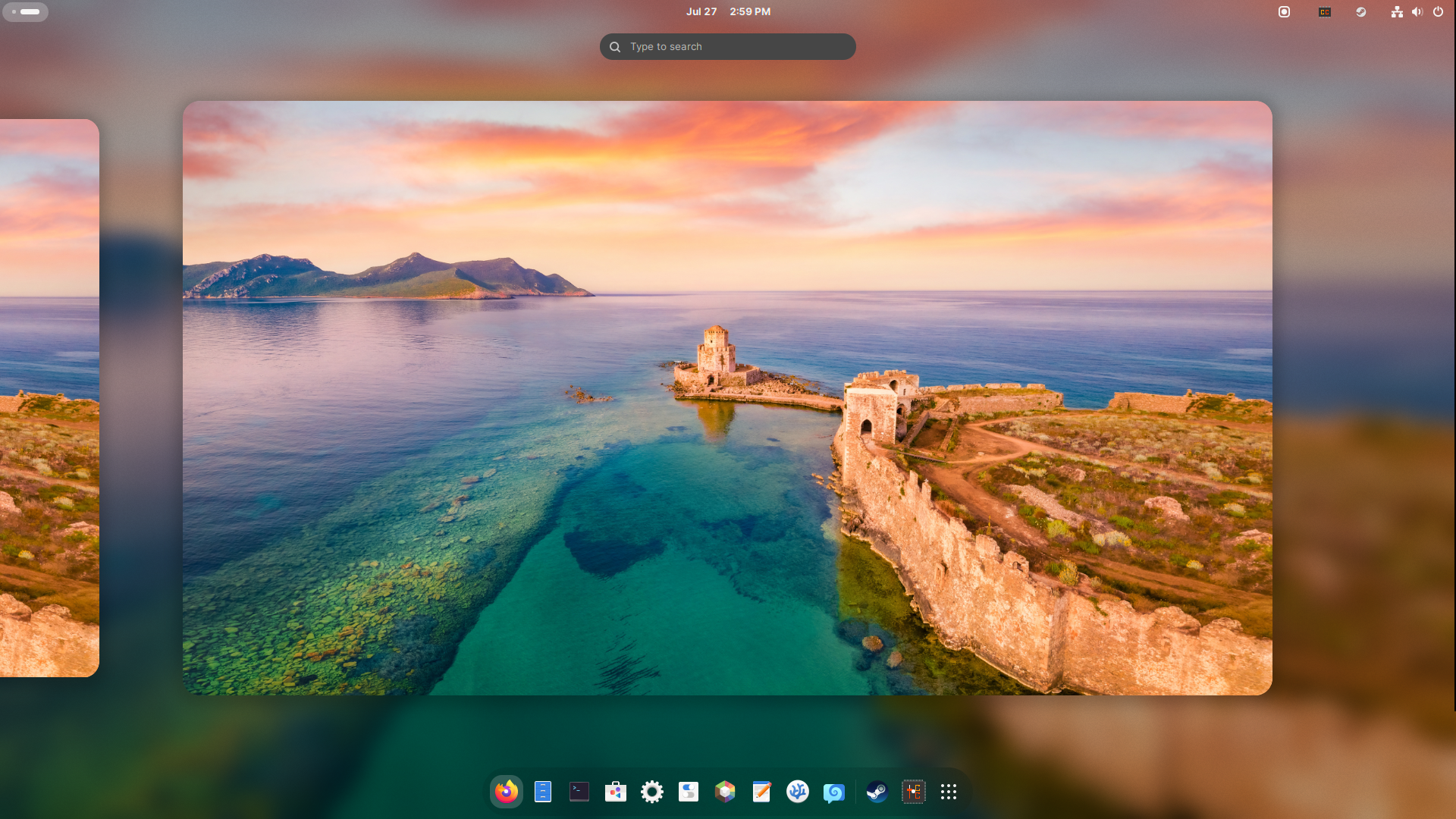- cross-posted to:
- linux@programming.dev
- linux@lemmy.ml
- cross-posted to:
- linux@programming.dev
- linux@lemmy.ml
The Linux Mint team has just released Linux Mint 22, a new major version of the free Linux distribution. With Windows 10’s end of support coming up quickly next year, at least some users may consider making the switch to Linux.
While there are other options, paying Microsoft for extended support or upgrading to Windows 11, these options are not available for all users or desirable.
Linux Mint 22 is a long-term service release. Means, it is supported until 2029. Unlike Microsoft, which made drastic changes to the system requirements of Windows 11 to lock out millions of devices from upgrading to the new version, Linux Mint will continue to work on older hardware, even after 2029.
Here are the core changes in Linux Mint 22:
- Based on the new Ubuntu 24.04 package base.
- Kernel version is 6.8.
- Software Manager loads faster and has improved multi-threading.
- Unverified Flatpaks are disabled by default.
- Preinstalled Matrix Web App for using chat networks.
- Improved language support removes any language not selected by the user after installation to save disk space.
- Several under-the-hood changes that update libraries or software.
I switched my main gaming computer to Mint after testing it on a laptop. Being away from Windows is awesome. You know how everything always wants your attention on Windows? Your antivirus proudly announces its existence. Windows wants to know if it should remove some printers? Some PDF software needs updated RIGHT NOW. There’s a license change please acknowledge this 20 page document. Animated attention grabbing everywhere. I always think FUCK OFF when presented with this bullshit.
You know what - Mint doesn’t do that. I’ve not been internally shouting at my own computer since I went that way.
It is serene.
How has your gaming journey been so far? Games and general programs are the main reason why in still on Windows
I switched to Linux Mint a couple months ago and use Steam a lot. I’ve tried at least 10 games and all worked perfectly.
But I don’t do competitive multiplayer. Those are more likely to have issues with anti-cheats. Although I did try Hell Let Loose and Helldivers very successfully and those are both major online titles.
Check https://protondb.com if you’re worried about a specific game’s compatibility. I’ve had silver rated games work perfectly though.
Edit: Apps - Photo editing and 3D CAD are the main areas I’ve struggled with on Linux. There’s no good Adobe equivalent, and no good Fusion 360 equivalent. Free CAD exists, but that can gently fuck off.
Apps - Photo editing and 3D CAD are the main areas I’ve struggled with on Linux
Yeah, I feel that. Paint.net is the sole reason I still fire up my Windows VM every now and then.
The closest you can get is Pinta and even then, looking at the surface things may seem very similar, but the workflow is totally different (it doesn’t even have overscroll god damn it!) and the plugin scene is deader than dead. I wanted to code a proper replacement based on Pinta, but I haven’t got the motivation or time for that.
If I wanna edit an image, firing up a VM is still genuinely faster than trying to work with Pinta or GIMP or any other opensource alternative for that matter. Krita has surprisingly been pretty good at replicating the workflow, but it still falls short.
Thanks for the link! Will definitely check out my top played games, unfortunately I play a lot of multiplayer games like Dota, Hunt, CS and War Thunder.
Photo editing and 3d modelling is something I do a lot which is a deal-breaker for me personally. Blender works on Linux afaik but stuff like substance painter/designer, Houdini, plasticity etc I don’t know
I don’t know about Hunt, but War Thunder and Dota have official Linux clients.
Steam + Proton works for most games, but there are still rough edges that you need to be prepared to deal with. In my experience, it’s typically older titles and games that use anti-cheat that have the most trouble. Most of the time it just works, I even ran the Battle.net installer as an external Steam game with Proton enabled and was able to play Blizzard titles right away.
The biggest gap IMO is VR. If you have a VR headset that you use on your desktop and it’s important to you, stay on Windows. There is no realistic solution for VR integration in Linux yet. There are ways that you can kinda get something to work with ALVR, but it’s incredibly janky and no dev will support it. There are rumors Steam Link is being ported to Linux, nothing official yet though.
On balance, I’m incredibly happy with Mint since I switched last year. However, I do a decent amount of personal software development, and I’ve used Linux for 2 decades as a professional developer. I wouldn’t say the average Windows gamer would be happy dealing with the rough spots quite yet, but it’s like 95% of the way there these days. Linux has really grown up a lot in the last few years.
Thanks for the detailed reply. VR isn’t a deal-breaker for me currently but your last paragraph is great, most of the videos I’ve watched have echoed that sentiment of “It works great… Most of the time”
I do want to give Linux a try when I have some time over for trouble shooting and fixing. I feel like a Mac person when I say that lol, “I just want it to work”
Things with kernel anti-cheat aren’t going to work unless they have a Linux version. So no Helldivers, Valorant, Apex Legends, etc.
Other than that, I have yet to find a game that doesn’t work under Proton. They’ll tell you it’s Windows-only until you go into the game’s steam compatibility settings and set it to Proton Experimental and then it just installs and runs no problem. Even things I didn’t really expect to work, I booted and played Trepang2 under Proton just last night, not a problem in sight.
Along with Helldivers 2, I can confirm Apex Legends works as well. Valorant as far as I’m aware is a definite no-go though.
Just adding on, ProtonDB is a great resource for checking game compatibility!
Thanks to you and jettrscga for letting me know! I think that may not have always been the case, I seem to remember Helldivers pretty specifically didn’t have Linux support when I was last playing it. Or maybe I’m just crazy.
Apex I for sure just assumed wouldn’t work, without trying, because of aforementioned kernel anti-cheat. Good to know I was wrong there even if I don’t like the game that much myself.
Helldivers 2 works on Linux by the way. It was the first game I installed on Linux and I have almost 100 hrs on it. I haven’t tried the others you mentioned though.
Not the person you asked to but my gaming experience has been stellar. If you use Steam you don’t have to do anything, it all works out of the box. If you don’t play those multiplayer games with kernel level anti cheats you’ll be fine.
I was expecting a bad time and was extremely impressed. Gaming in Linux is amazing.
Some of those with anti cheat even work, I’ve been playing Helldivers 2 with no issue
Last I heard, Destiny 2 could be running fine, their anti cheat supports Linux, but Bungie still bans people for trying
That serenity is why I enjoy running Arch with basically nothing on it. My OS doesn’t do shit and I love it
I like the way Linux handles updating software better.
On Windows, every app is installed separately so each app is internally responsible for its own updates. So you sit down to do some work, open up your productivity software and “Autodobe After360 requires an update to continue. [Yes] [Yes]” This isn’t impossible on Linux but it happens much less often.
As you say it doesn’t throw itself under your wheels as often as Windows does.
I made the switch to mint a few months ago. Its astounding to me just how slowly windows boots and I never noticed until I made the switch.
You got me, Lemmy. I caught the Linux from you and I can’t go back.
Mint boots SHOCKINGLY fast, like sub 2 seconds, on a couple of systems I have. Its basically as fast as “booting” one of my old Commodore computers!
<2 seconds from powered off to being able to start to open e.g. a web browser?
If so that is indeed truly shocking. Curious what your stopwatch says from powered off to a homepage loaded ready to use.
Did not see “faster than Commodore 64!” coming!
Did not see “faster than Commodore 64!” coming!
As an American I am required by our Constitution to use bizarre units of measure. 😊
Last I checked, one desktop computer with Mint installed = seventeen TRS-80s.
That’s equal to 68 TI-84s!
Booting from a full power off state?
Reboot but a cold start isn’t exactly fair because the Commodore doesn’t have a BIOS / UEFI splash screen. Although now that you bring it up I’m slightly interested in timing it and seeing exactly how fast I can make the cold start process.
I researched this a few years ago, but is their a way to get SolidWorks, SpaceClaim etc working on Linux? Or do I have to run a virtual machine with windows?
Switching to Linux is almost always going to involve accepting that you may need to use alternative software compared to what you’re used to. If that’s unacceptable and you have mission critical work that can only be done on Windows compatible software, you may be better off staying put.
I was not successful running Solidworks under Linux and it even detects when it is running in a virtual machine and refuses to install completely!
Finally I have found an alternative that suits my needs, that has free account for hobby purposes: on-shape.com it’s web-based, works flawlessly under Linux and Firefox. Workflow is very similar to Solidworks, and version-control is simple and nice.
Doesn’t onshape originate from a bunch of SW engineers so that’d make sense!
Personally, I was paying for SW with a maker license but this year I’ve committed to Freecad, use realthunder’s fork that has the topo naming fix + modern ui workbench for a more familiar layout.
I would call it totally useable, workflow for me ends up the same or similar to solidworks, I tried fusion because that’s really popular but it didn’t click with me while freecad did. I won’t pretend it’s flawless and doesn’t have quirks but I’m willing to accept that for foss, need to spend a bit of time with it to get used to what it expects you to do but it’s really powerful once you do.
Some people have run solidworks on Linux with limited success. Granted I have never personally done it, from what I understand they used wine which emulates windows anyway. So it depends on how much time you are willing to sink to get things working.
Not to be critical of your input but wine is not an emulator (which is wine’s acronym), it’s actually a translation layer that converts windows calls into Linux on the fly, which can be a lot faster than emulating windows. Add to the original person’s question a quick Google led me to this project
I recently gave thr debian based Linux Mint a try and I was pleasantly surprised.
I might ditch ubuntu for this.
Just curious, if you’re already using Ubuntu why try LMDE rather than the default version?
The default version of what?
Of Linux mint. The Cinnamon edition that pulls a lot from Ubuntu as well as Debian. That’s what got upgraded to version 22, along with the could other flavors. But Linux Mint Debian Edition (LMDE) does not follow the same versions & release schedule.
Oh, like that.
Well, mainly because I’m getting a little fed up with how Ubuntu forces snap on to you. I just want to install the apt versions of programs but it won’t do that out of the box.
And I know you can change that and remove snap but I am a little done with always having to mod the shit out of my linux installations to get them to work the way I like.
Other than that I am pretty satisfied with how Ubuntu works out of the box and has pretty good hardware support. I was basically looking fot an Ubuntu without snap.
Ubuntu without snap is exactly what Mint Cinnamon is! You get to lean on all those popular Ubuntu resources and use apt and all that good shit.
It is? I did not know that! Thank you very much for enlightening me! I’ll be giving that a try now.
Glad to help! They do include flatpak stuff in the software manager if you use that, but they are marked as such.
I checked this morning and I have no flatpaks installed and snap/snapd itself isn’t even installed on my system.
I love mint, and Fedora Cinnamon is my daily driver. My only problem with cinnamon is that wayland support is still being developed, so it lacks 1:1 touchpad gestures.
Also can’t run 4k at 60hz on my system at least. That’s a total nonstarter for me.
Can it run steam and autocad?
Also amd gpu support. I had to abandon mint 5 years ago because of poor driver support.
Latest kernel is probably what you need if things work on other distros. There’s a menu in the Mint update manager you can use to change to a slightly newer kernel and I would always advise that if it doesn’t cause any other issues. Newer kernel usually means more and newer drivers.
Mint is ultimately based on Debian, but with a lot of newer software, although it’s “stable” under the hood. That’s why Mint is popular on personal home computers. The idea behind it is that it should give you all the updates you need, but not too often or in a way that breaks things. If your computer works on one version of Mint, it would hopefully never break from an update, but packages don’t tend to be cutting-edge.
Steam is sort of an exception there. It works well on the vast majority of distros because Valve’s CEO is a bit unusual in that he prefers people to be using Linux and has done a lot to keep it working well. If you don’t use the flatpak for Steam (which I wouldn’t suggest), then it runs in its own kind of custom runtime container that makes sure it works as it’s supposed to in the vast majority of Linux distros.
I’ve never used Autocad, so I couldn’t say too much about it. If a program doesn’t work properly it could be due to incompatible dependency packages with different behaviour. Autocad would also be a graphics heavy program (similar to Blender, but also like videogames) so drivers could come in there too. The updated libraries might help, or it could just be your graphics drivers again. You can also try the flatpak version instead if it doesn’t work, and vice versa.
If you can get your GPU to work on other distros, you shouldn’t have many problems on this new major version of Mint, so long as the kernel is new enough, which I think it would be.
If you have a specific, very new, AMD GPU, there are actually public records of what the developers of the Linux kernel are doing to support newer hardware. Most people don’t find these easy to check, but this would be a common question. There is a long wikipedia page giving a few of the most well-known optimisations, bug-fixes and hardware support improvements in specific versions of the Linux kernel.
By the way, there are lots of people on the official Linux Mint forums who are happy to answer specific questions about bugs or what’s improving in Linux Mint, as posed by community members.
I’ve been using Mint exclusively for quite a few years now (outside of Android) and had minimal issues, outside of poorly refurbished laptops I got for cheap (like one with a physically broken keyboard that spammed one of the buttons, which I was able to fix easily with a simple script I copied from the web).
Sorry if that was too long an answer, but what I’m saying is there is a good chance it will just work out if you try to install this new major version (though there’s some chance it might not). Also I believe they’ve decided to prioritise shipping a kernel with good hardware support now, rather than a more “stable” one (older/LTS) so a lot of more recent hardware will work, unlike 5 years ago.
Don’t be afraid of following a few CLI guides if you have to either. Any distro is good enough if you know a few terminal commands, and any distro can be perfect if you’re an absolute bash wizard.
Hope that helped.
Technically Mint is based on Ubuntu (this release is based on Ubuntu 24.04 which released earlier this year).
Mint decrapifies Ubuntu by removing things like Snap, I’m going to switch to Mint eventually - honestly maybe even later this year, maybe in December or something.
Ubuntu is based on Debian, although they made quite extensive changes over time. Ubuntu and Mint are very similar, but Ubuntu is owned by a corporation called Canonical that people have had a few concerns about the priorities of, whereas Mint is community ran.
My bad. Autocad is commercial software that mainly supports Windows, so you would have to see if you can set it up through Wine (popular for running Windows software on Linux).
Mint ships with 6.8 now
Autocad AFAIK doesn’t run, I am trying to get something like nanocad to work, also any version of SAP2000, ETABS or Staad.
Steam & amd yes, autocad no
Not sure about AutoCAD, but I have Mint installed to the expansion card drive on my Frame.work and have been playing a fair amount of Inscryption, FTL, and Stronghold Crusader on it through Steam, so I would say yes?
I would try to run autoCAD by adding it to steam as a game and set it to use proton and look what happens 🤔
Mint is my daily use OS at work, and will soon be taking over my windows machine at home that acts as a server.
I’m sure it’s a side effect of me being old and being busy all the damn time, but I love that it can literally be easier to install and use than windows, without losing any linux-ness. Big deal if it looks like I have a windows taskbar, I still have my screens taken up by Firefox, VSCode, terminal.
Switched to Linux Mint about three years ago after being unable to take my perfectly good laptop from W10 to W11. Dual boot firstly, quickly becoming entirely Mint. It just worked. It was the first Linux distro I’d tried in about 20 years that I didn’t mess up in a week or so.
Recently bought a new laptop and decided to distro hop. Tried various flavours of Fedora, and a few others, but ultimately came back to Mint. None of the others worked quite as well as Mint does for me (though I really liked KDE Plasma, and Gnome surprised me once I finally discovered extensions!)
You can put Plasma on Mint, I’m running that right now myself
When I rebuilt my PC I was planning something similar, got two nvme drives to dual boot, but started with Linux Mint… And never wound up installing Windows on the other, never felt the need, so I finally last night formatted it for more room for all my games
I did try running Plasma on Mint, but it was never quite as good as on Fedora or as smooth on Mint as Cinnamon.
Honestly, I think I just like the simple uniformity of Cinnamon. It’s dull and predicable, but really, really solid.
I really liked Cinnamon but switched mainly because I kept having occasional video problems that didn’t seem to affect KDE… But, that might have been the lack of a proper video driver, I’ve not tried switching back since fixing that
At this point, I’ve found enough with KDE that I like having in my workflow that I’ve been reluctant to try switching back
Did I blink and miss something… Mint actually looks pretty modern compared to how I remember the release notes, kernel 6.8… I’ve never bothered with it as it just seemed like a distro to run on old hardware if you don’t mind your core being 2 years out of date, where Debian v.xx with kde just made more sense
Interesting…
It’s solid. I game all the time on it. I don’t do much else on my home PC. Watch videos and movies. It’s solid enough that I have abandoned Windows completely. I still deal with it with my work laptop, but I don’t give a shit. It’s not my money there.
I’ve got an older Latitude that I’ve nearly maxxed out on a shoestring budget, it runs LMDE 6 and is my dedicated Linux machine. I use it for online study, Zoom sessions, content consumption, and some Python here and there, LMDE is rock solid and hasn’t given me any fuss at all.
Unless LM22 has undergone some significant changes, I would say LMDE 6 doesn’t feel “modern” but it feels polished
Oh so is this 22 like the rolling release Vs that? I should just look it up but I made both these comments on the toilet and hate web browsing on mobile 😄
Kind of, its based on the latest LTS of Ubuntu if memory serves me right
I try to avoid Ubuntu for a lot of the common reasons seen here, so a Debian based Mint suits me well
Okay so as someone who’s getting fed up with Windows and Microsoft as a whole, I’m interested in Linux.
I just wanna game and watch videos. Video calls n such with friends. Nothing too spectacular.
Now can someone who doesn’t work on computers for a living, or even isn’t a hobbyist programmer. Someone like me, who couldn’t write a line of code on their own, answer me how difficult would it actually be?
My biggest fear is that I’m convinced by all the tech nerds here who can of course run this no problem and don’t see why a beginner would struggle, and then my anxiety shoots through the roof while I have a breakdown because I just wanted to get home from work and relax and suddenly my PC is a paperweight.
Dead easy with Mint. I’ve been running it full time on my laptop for months now and my wife only recently came to find out it wasn’t windows when I was explaining Linux to her (and she’s not a technical personal - she’s the person who yells at TV remotes when they don’t work). Installation is super easy, much like installing windows - answer a few questions and off it goes. You can even install it alongside windows and pick what one you want to run on boot (I did this because of a couple windows-only apps I can’t ditch just yet). If you can figure out Lemmy, Mint will be a breeze too.
Do you sacrifice anything performance-wise by having the dual-boot?
After not even two years my beast pc I have for work has started giving me BSODs, apps crash, etc. Tried a bunch of stuff to troubleshoot hardware side, software side, short of buying new expensive parts like ram etc to test, or reinstalling the OS.
I do mostly video editing, sound editing, and Photoshop+Lightroom mainly, with some 3D, vector and stuff like that here and there. I think most of my software runs on Linux except the Adobe stuff. I’m curious to try Linux see if it would solve some of the problems but afraid that even the dual booting stuff would still be a pain if I need to switch between PS+LR to other tools a lot.
no perf. loss with dualbooting, just takes more space.
The other reply answered your performance question already, but to address your concern about switching between OS’s for different program needs - you could always run windows in a virtual machine on Linux and just use Windows and the needed Windows software that way without having to fully reboot into Windows. This is the direction I plan on eventually going someday with my own setup and using Tiny11 for a lightweight windows VM.
I’m gonna give it a go after this current job is delivered!
What do people use to replace Microsoft Office these days? Have they got wine working well enough to run them yet or are you still stuck with open source alternatives?
Libreoffice, onlyoffice and ms office online mean that unless its a big part of your job, you dont need ms office
I’ve found that Libreoffice Calc in particular tends to deal with Excel files very well. It can do everything I’ve ever needed to do in Excel. The browser version of MS Office is good for full compatibility if you have access to it, but can be a bit annoying to use.
MS Word and Libreoffice Write never seemed to understand each other’s file formats well for me, especially if you insert equations in text. You can end up with weird formatting that’s laborious to correct. It might be best to avoid Libreoffice Write, especially for technical stuff, unless it’s improved a lot since then. The online MS Office could help you a lot there.
Latex is arguably the best for that sort of thing, but can be hard to use, since you have to learn it. Still, anyone should be able to open a pdf and get consistent results.
WPS Office is another option but I’ve never used it. It has official support for a surprising number of operating systems and seems to work well on different file formats. I’ve seen someone else use it with no complaints, and it does have official Linux support, even though it’s a commercial proprietary software, which can be inconvenient.
I save in odt and my teachers havent had any issues with the libreoffice files ive sent them
I sent an odt file to a teacher, and the response was, “don’t use open office, use Microsoft office for school” (I use libre office). I asked if he needed me to resend it, and he said that Ms office opens odt fine (¿_?). I started saving as docx in libre office, and he was never the wiser.
Seems like your file worked properly and they were just a bit initially confused by it, but obviously you should export as whatever file format you’re asked to if it’s been requested of you.
Did the document have lots of equations, pictures or tables in it? Do the documents you make tend to?
There were no communicated filetype requirements for the first assignment. Since I know MS office works with open doc formats, I wasn’t worried. He didn’t tell me to send MS office formats. Instead, he told me to use MS office. I wasn’t going to pay (even discounted) for a product that has (for me) been 100% replaced with libreoffice. So, I tried just sending him the files in MS office formats, which worked to appease his requirement. He later did send an email to the class, asking that we only use MS office and avoid foss office programs. I realized it was him misunderstanding how these software work, so I didn’t really sweat it. I’m assuming there was some incompatibility with their cheat-check saas that caused this requirement.
There were some embedded objects in nearly all of the docs, but no equations.
There are the FOSS ones, but when I’ve swapped people over from Windows or Mac and they want something familiar, I give them WPS Office. It’s pretty much a drop in replacement for Word/Office.
I want to say I’d put them on LibreOffice, but it’s too fucking weird and buggy for someone coming off of Office.
I’ve used OnlyOffice (FOSS, really modern) and Softmaker Office, which is a proprietary German alternative with native Linux support. It also has the best docx compatibility of the Microsoft alternatives.
“Stuck with”? I find open source alternatives far less infuriating to work with than anything Microsoft produces.
Depends on your requirements. I am mostly able to get along with LibreOffice and I tried Collabora, though both suck in their own way. Winedb says that Office 95 and 2013 have “Gold” rating. Maybe I will try later next week to install the 2013 version.
I know it’s bad to say but MS office is a real barrier. That and done other compatibility issues with Windows apps made me abandon Ubuntu for Windows after several months where I otherwise loved it.
For me it’s that a game I regularly play really needs their rootkit to run before they allow me to start it… If that ever changes or I stop playing it I’ll take a long hard look at Linux.
I am currently using windows, but Microsoft office could easily be replaced with WPS office on linux, there will be some niche features (Power query, Microsoft Access,… Etc) that will not work for linux but the rest is covered on linux.
I just did the upgrade this morning. Shocker: super easy, went seamlessly, and didn’t make my computer unusable for a chunk of time like big windows updates do.
these days I recommend fedora kinoite to beginners from windows.
their os-tree package manager sucks it somtimes will refuse to uninstall stuff
You’re not supposed to use that, and in fact, when i give it to beginners, i don’t mention the package manager, I just use discover with flatpaks.
oh,but flatpacks are missing native hosting on some browsers but its mostly not a big problem and not all apps are on flatpack
Nearly everything the average person needs is in flatpak.
I don’t know what you mean by “native hosting”
Nearly everything the average person needs is in flatpak.
True tho
I don’t know what you mean by “native hosting”
I meant native messaging
It’s a good distro and it is a lot harder to break on accident, but there are a lot more minor kinks than fedora workstation. It can also get confusing for newcomers on the somewhat regular occasion that you need a non-flatpak package.
Can you give some examples of these kinks? I haven’t had any issues giving it to beginners.
Just from my own experience, many flatpak apps such as Steam, VSCode, or Kdenlive have a lot of issues, and many other flatpaks are maintained by third parties with poor quality control. This isn’t Silverblue/Kinoite’s fault, but it is still an issue that affects it. For certain machines where drivers aren’t included by default, it requires a lot more troubleshooting to install them compared to Linux Mint’s driver manager, or even just copying a few commands from the internet on a distro like Fedora.
Ah, the driver thing is mitigated by me doing the installation for them.
As for flatpaks having issues, that makes sense, i try to stick to verified flatpaks and do tell them to avoid unverified ones. I just really haven’t had these problems, have you had them recently or historically?
It’s more of a historical problem, and I’ve always been able to solve it. Not everyone has the time or patience that I do though, especially when it involves changing permissions with flatseal. Overall though, the fedora atomic versions are solid, and it’s ok for beginners. It just adds a slight bit of complexity plus less resources for troubleshooting than linux mint or ubuntu.
Tbf, most distros work on older hardware.
Linux Mint was my gateway drug to linux. It’s simple and powerful! Now I’m a happy KDE user, but you never forget the first love
Plasma is quite nice now.
It really is. I don’t get the love for the tabletish gnome interface everyone is using.
I get why some people like it, for sure. I’m just surprised so many “power users” seem to.
It has a unique workflow which clicks for people like me, even if they’re on a desktop. It encourages workspaces by making creating and switching between them instant and seamless, and i like seeing all of my windows at once by just pressing the super key.

Oh I love your wallpaper, do you have a link to somewhere I can download it?
Sure, I use an extension to get daily wallpapers, but here’s the image for that day:

Thank you!
Gnome is just perfect for laptops and convertibles. I can quickly navigate it using the touchpad and super key. It also has better touch screen support, and with one extension (hide top bar), literally all of the screen real estate is available for your work. Hit the super key or 3-finger-swipe up and the UI appears. Do it again to show all your applications and desktops. Or just start typing to search. 3-finger-swipe sideways to switch to another virtual desktop. All my programs are full-screen and on their own desktop. The animations are so smooth, it’s a joy to use.
And the Gnome apps are just simple and reduced to what you actually need.On a desktop PC I prefer Plasma for its customizability and smaller UI elements. It’s better for navigating with a mouse (although you can also turn it into a Gnome-clone or a tiling WM just with built-in options). And the KDE apps feel more “professional”, with lots of additional functionality, options and settings.
I’m glad both exist.
I use Plasma on Mint. Love my setup
Did you match the theme to look like cinnamon?
I ran a dual-boot for a month and a half when news about Windows Recall broke, but unfortunately, my Nvidia setup experienced a lot of bugs and proved to just be too incompatible.
So, when I upgrade to a new computer later this year, I’m going to make this machine a Linux-only machine with a different distro, and then have my other PC for all my gaming needs.
You probably needed to download some drivers for your gpu
I tried several.
None of them functioned well, and over that period of time it became clear it was a system issue. But, I know there are other distros that are more Nvidia-friendly, and when the time comes, I’ll use one of those.
Thankfully there’s O&O ShutUp to turn off Windows tracking for now.
That’s probably the main issue with Linux. Drivers. If you own many peripherals the switch is quiet impossible. Most of them are not addressed and when it is it is far to be plug and play. And wasting hours to setup one periphecal can be very frustrating.






















